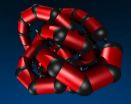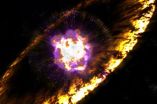Rutgers physicists test highly flexible organic semiconductors
Research paves way for thin-sheet plastic displays or wearable electronics
2013-02-15
(Press-News.org) Organic semiconductors hold promise for making low-cost flexible electronics – conceivably video displays that bend like book pages or roll and unroll like posters, or wearable circuitry sewn into uniforms or athletic wear. Researchers have demonstrated the ability to "print" transistors made of organic crystals on flexible plastic sheets, using technology that resembles inkjet or gravure printing.
However, for the technology's potential to be realized, scientists have to show that these organic semiconductors will withstand the rugged handling they invite – they will need to perform reliably in spite of frequent flexing and sharp bending.
In an article published Dec. 11, 2012 in Nature Communications, scientists led by Rutgers University physicist Vitaly Podzorov report they have demonstrated extremely flexible organic semiconductors that withstood multiple bending cycles in which the devices were rolled to a radius as small as 200 micrometers. The scientists worked with numerous crystalline devices they made and found no degradation in their performance.
Podzorov claims his is the first rigorous study of solution-crystallized organic semiconductors under various types of strain - sharp bending and repeated flexing along with compression and stretching. He acknowledges some earlier encouraging studies of mechanical robustness, but felt those lacked rigorous tests of flexibility involving different types of organic semiconductors, especially those that show the most promise for development of low-cost printed electronics. The scientists at Rutgers focused on two soluble small molecules (developed in the group of Prof. John Anthony at the University of Kentucky), depositing and crystallizing them on thin plastic sheets from solution, and claim the results should apply to numerous other organic formulations that researchers are investigating.
###
Podzorov is an associate professor in the Department of Physics and Astronomy and a member of the university's Institute for Advanced Materials, Devices and Nanotechnology. He collaborated with Rutgers postdoctoral researcher Hee Taek Yi and with Marcia Payne and John Anthony of the Department of Chemistry at the University of Kentucky. The work at Rutgers was funded by the Chemistry of Materials program of the U.S. Department of Energy, and the effort at the University of Kentucky was funded by the Office of Naval Research.
The Nature Communications abstract and article (subscription required) can be viewed at: http://www.nature.com/ncomms/journal/v3/n12/full/ncomms2263.html. END
ELSE PRESS RELEASES FROM THIS DATE:
2013-02-15
Wcologists from Umeå University and the Norwegian University of Science and Technology in Trondheim have studied fish communities and fish habitat and reviewed the importance of winter conditions for fish in streams and rivers in cold regions. The findings are now being published in the journal BioScience.
It is well known that winter can be a stressful season for plants and animals in streams and rivers. It is reasonable to assume that more extreme weather conditions are the most taxing, but the ecological significance of this is poorly understood.
The research team, ...
2013-02-15
University of Cincinnati-led research takes a new direction in examining the availability of healthy foods for urban populations by examining the commuting patterns of its residents.
This new approach to identifying so-called food deserts, now published online, will appear in the May journal of Health and Place.
Neighborhoods without access to stores that provide healthy food options – such as fresh fruits and vegetables – are often labeled as food deserts. However, current methods for determining which neighborhoods have access to nutritious foods focus only on where ...
2013-02-15
This press release is available in German.
Physicists of the University of Vienna together with researchers from the University of Natural Resources and Life Sciences Vienna developed nano-machines which recreate principal activities of proteins. They present the first versatile and modular example of a fully artificial protein-mimetic model system, thanks to the Vienna Scientific Cluster (VSC), a high performance computing infrastructure. These "bionic proteins" could play an important role in innovating pharmaceutical research. The results have now been published in ...
2013-02-15
Having diabetes doubles a person's risk of dying after a heart attack, but the reason for the increased risk is not clear. A new University of Iowa study suggests the link may lie in the over-activation of an important heart enzyme, which leads to death of pacemaker cells in the heart, abnormal heart rhythm, and increased risk of sudden death in diabetic mice following a heart attack.
"Many studies have shown that patients with diabetes are at especially high risk for dying from a myocardial infarction (heart attack). Our study provides new evidence that this excess ...
2013-02-15
UNIVERSITY PARK, PA. -- Researchers have studied viruses as agents of disease in humans, domestic animals and plants, but a study of plant viruses in the wild may point to a more cooperative, benevolent role of the microbe, according to a Penn State virologist.
"Most of these wild plants have viruses," said Marilyn Roossinck, professor of plant pathology and environmental microbiology and biology, who has examined more than 7,000 individual plants for viruses. "But they don't have any of the symptoms that we usually see in crop plants with viruses."
Most of the viruses ...
2013-02-15
Highlights
A technique that removes additional toxins during dialysis decreased kidney failure patients' risk of dying from any cause by 30% over three years.
The technique also reduced patients' risk of dying from heart-related causes or infections.
15% to 25% of dialysis patients die annually.
Washington, DC (February 14, 2013) — A technique that removes additional toxins during dialysis may prolong kidney failure patients' lives, according to a clinical trial appearing in an upcoming issue of the Journal of the American Society Nephrology (JASN). In light of ...
2013-02-15
We are constantly being bombarded by speedy, energetic, and yet unassuming, particles called cosmic rays. These charged particles (mostly protons), continuously assail the Earth from outer space. There is general consensus among scientists that supernova remnants (the leftovers of a supernova explosion) are the sources of cosmic rays, but the final proof has been elusive since cosmic rays are deflected on their way from the source to Earth.
A new study offers conclusive evidence that cosmic ray protons within our galaxy are accelerated in the shock waves produced by ...
2013-02-15
Anxiety-moderating drugs that reach waterways via wastewater create fearless and asocial fish that eat more quickly than normal. These behavioral changes can have serious ecological consequences. This is shown by Umeå University researchers in the prestigious journal Science.
Many drugs leave our bodies unaffected, and residues from them are therefore found in wastewater. Low concentrations of drugs are often found downstream from sewage treatment plants. Today we test how dangerous drugs are to humans, but our knowledge of the environmental impacts of drugs is limited. ...
2013-02-15
Pharmaceutical drugs that end up in the world's waterways after being excreted, flushed and treated at wastewater treatment plants may lead to unexpected ecological impacts, according to a new study of wild European perch. Tomas Brodin and colleagues from Umeå University in Sweden discovered that the fish ate faster, became bolder and acted less social after being subjected to an anxiety-moderating drug, known as Oxazepam.
The psychiatric drug is used to treat anxiety in humans. But, Oxazepam residues often wind up in natural aquatic systems, downstream from sewage treatment ...
2013-02-15
Menlo Park, Calif. — A new study confirms what scientists have long suspected: Cosmic rays – energetic particles that pelt Earth from all directions – are born in the violent aftermath of supernovas, exploding stars throughout the galaxy.
A research team led by scientists at the Kavli Institute for Particle Astrophysics and Cosmology at the Department of Energy's (DOE) SLAC National Accelerator Laboratory sifted through four years of data from NASA's Fermi Gamma-ray Space Telescope to find the first unambiguous evidence of how cosmic rays are born.
Reporting in the ...
LAST 30 PRESS RELEASES:
[Press-News.org] Rutgers physicists test highly flexible organic semiconductors
Research paves way for thin-sheet plastic displays or wearable electronics




